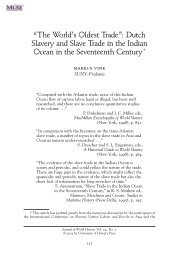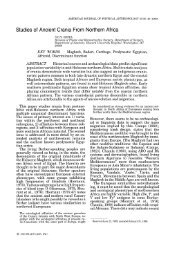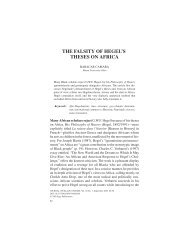The Astronomers of Nabta Playa
The Astronomers of Nabta Playa
The Astronomers of Nabta Playa
You also want an ePaper? Increase the reach of your titles
YUMPU automatically turns print PDFs into web optimized ePapers that Google loves.
Art by Ron O. Cook<br />
filled with seasonal lakes. Excavations<br />
through the 8—12 feet <strong>of</strong> sediments laid<br />
down during this period showed that some <strong>of</strong><br />
the megaliths had been buried intentionally.<br />
<strong>The</strong> team also found strange carvings in the<br />
bedrock under the sediments–––evidence <strong>of</strong><br />
great antiquity.<br />
<strong>The</strong> archaeologists mapped the area and<br />
used global positioning technology (GPS) to<br />
plot the locations <strong>of</strong> 25 individual megaliths.<br />
Many others remain to be plotted. Fortunately,<br />
the site’s remoteness protected it<br />
from most human disturbance. Though the<br />
mapping data hinted at astronomical significance,<br />
Wendorf’s team searched in vain for<br />
the key to unlock the site. In 2001 they presented<br />
their research in a book edited by<br />
Wendorf, Holocene Settlement <strong>of</strong> the Egyptian<br />
Sahara. <strong>The</strong> two-volume study makes<br />
for interesting reading. But its authors had<br />
few answers.<br />
However, even as Wendorf’s book was in<br />
press, a former NASA physicist named<br />
Thomas Brophy was quietly pursuing his own<br />
astronomical study <strong>of</strong> <strong>Nabta</strong> <strong>Playa</strong>. Brophy<br />
had already reviewed the sparse data published<br />
in Nature in 1998, and after Wendorf’s<br />
more extensive data became available his nascent<br />
theories fell into place. In 2002 Brophy<br />
presented his findings in <strong>The</strong> Origin Map. Because<br />
the available astronomy s<strong>of</strong>tware was<br />
inadequate Brophy had to custom-engineer<br />
his own. Thus armed, he was able to track<br />
star movements at <strong>Nabta</strong> <strong>Playa</strong> over thousands<br />
<strong>of</strong> years, and succeeded in decoding the<br />
stone circle and nearby megaliths. <strong>The</strong> Cal-<br />
Physicist Thomas Brophy beside megalith “A-O”<br />
endar Circle has a built-in meridian-line and<br />
a sight-line–––both conspicuous–––which indicated<br />
to Brophy that the circle was a userfriendly<br />
star-viewing platform. Its design was<br />
so simple that even a novice could have used<br />
it. A night viewer between 6400—4900 B.C.<br />
stood at the north end <strong>of</strong> the meridian axis<br />
and allowed himself to be guided by three<br />
stones at his feet to the constellation Orion<br />
overhead. <strong>The</strong> correspondence between<br />
ground and sky would have been self-evident:<br />
<strong>The</strong> three stones within the outer circle are<br />
laid out in the precise pattern <strong>of</strong> the stars <strong>of</strong><br />
Orion’s famous belt, before summer solstice<br />
as indicated by the Calendar Circle itself.<br />
Once the pattern becomes familiar it is unmistakable.<br />
In another section <strong>of</strong> his book Brophy<br />
concluded that Robert Bauval and Adrian Gilbert<br />
were at least partly correct in their 1992<br />
study, <strong>The</strong> Orion Mystery, in which they<br />
claimed that Giza had a similar planned<br />
structure. Bauval and Gilbert argued that the<br />
pyramids <strong>of</strong> Giza were constructed to mirror<br />
heaven, laid out on the ground to represent<br />
these same three stars <strong>of</strong> Orion’s belt.<br />
Here, then, at <strong>Nabta</strong> <strong>Playa</strong>, was evidence<br />
<strong>of</strong> a common astronomical tradition <strong>of</strong> astonishing<br />
longevity. Just to give you some idea,<br />
modern astronomy is about 500 years old,<br />
yet, the astronomy common to both Giza and<br />
<strong>Nabta</strong> <strong>Playa</strong> survived for at least 6,000—<br />
7,000 years, possibly longer. <strong>The</strong> shared astronomy<br />
also suggests a shared cultural tradition.<br />
In fact, Wendorf’s team amassed considerable<br />
evidence <strong>of</strong> overlap between the<br />
neolithic <strong>Nabta</strong> culture and the much later<br />
Old Kingdom <strong>of</strong> Pharaonic Egypt, when pyramid<br />
building reached its zenith. It is interesting<br />
that more than a century ago Flinders<br />
Petrie, one <strong>of</strong> the founders <strong>of</strong> Egyptology, arrived<br />
at a similar conclusion. Petrie found evidence<br />
that the enigmatic Sphinx was not an<br />
Egyptian sculptural form at all, but had originated<br />
in Ethiopia.<br />
Brophy’s findings also support the work <strong>of</strong><br />
geologist Robert Schoch, who recently found<br />
telltale evidence <strong>of</strong> water erosion on the<br />
Continued on Page 68<br />
Number 56 • ATLANTIS RISING 43


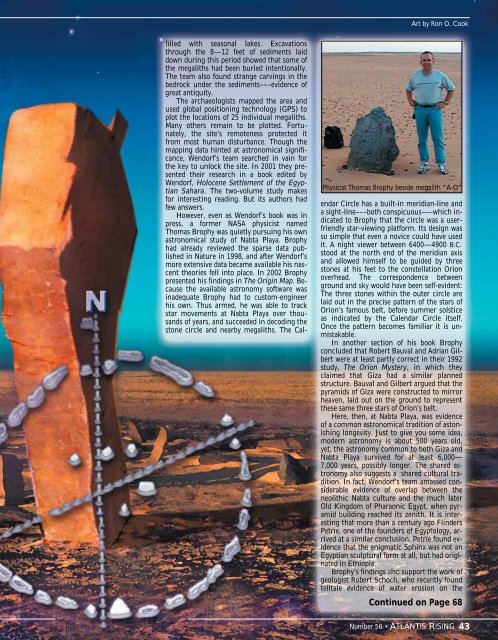

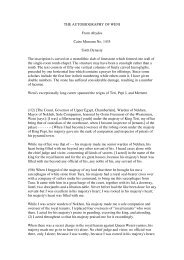
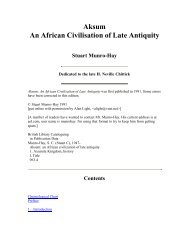
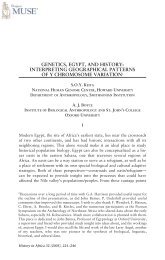
![The Negro trail blazers of California [microform] : a ... - Homestead](https://img.yumpu.com/32436613/1/174x260/the-negro-trail-blazers-of-california-microform-a-homestead.jpg?quality=85)
